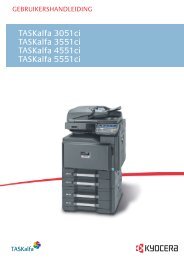1 Turn off the power of the printer. - Van Mechelen
1 Turn off the power of the printer. - Van Mechelen
1 Turn off the power of the printer. - Van Mechelen
- No tags were found...
Create successful ePaper yourself
Turn your PDF publications into a flip-book with our unique Google optimized e-Paper software.
10) When more data is to be received from <strong>the</strong> <strong>printer</strong>, <strong>the</strong> host chooses one <strong>of</strong><br />
three status selections:<br />
1. Setting HostBusy (nAutoFd) to Low and indicating that <strong>the</strong> host is ready to<br />
receive.<br />
2. Remaining in <strong>the</strong> Host Busy Data Available phase.<br />
3. Performing Termination and returning to <strong>the</strong> Compatibility mode.<br />
13.2.5 Device ID<br />
The device ID is a character string that provides <strong>the</strong> ID, <strong>the</strong> type, and o<strong>the</strong>r<br />
information regarding <strong>the</strong> <strong>printer</strong> connected to <strong>the</strong> interface. When <strong>the</strong> <strong>printer</strong><br />
receives a request for a device ID from <strong>the</strong> host, it replies with <strong>the</strong> following device<br />
ID:<br />
H H<br />
MFG : CBM ;<br />
CMD : ESC / POS ;<br />
MDL : CBM1000 ;<br />
CLS : PRINTER ;<br />
The first two bytes <strong>of</strong> <strong>the</strong> device ID indicate <strong>the</strong> length <strong>of</strong> <strong>the</strong> entire device ID<br />
(Including <strong>the</strong> first two bytes <strong>the</strong>mselves). For a description <strong>of</strong> a request for a<br />
device ID, refer to <strong>the</strong> “Negotiation” section earlier in <strong>the</strong> present Appendix.<br />
When <strong>the</strong> host receives <strong>the</strong> device ID string <strong>of</strong> <strong>the</strong> length indicated by <strong>the</strong> first two<br />
bytes, it must do so consecutively, without terminating <strong>the</strong> process until <strong>the</strong> entire<br />
device ID is received. If <strong>the</strong> process is terminated halfway, <strong>the</strong> <strong>printer</strong> discards <strong>the</strong><br />
rest <strong>of</strong> <strong>the</strong> string; when <strong>the</strong> <strong>printer</strong> receives a new request for <strong>the</strong> device ID, it<br />
sends <strong>the</strong> device ID beginning from <strong>the</strong> first character <strong>of</strong> <strong>the</strong> ID. After receiving <strong>the</strong><br />
ID <strong>of</strong> <strong>the</strong> length indicated by <strong>the</strong> first two bytes, <strong>the</strong> host must carry out <strong>the</strong><br />
termination even if <strong>the</strong> <strong>printer</strong> has data to send (Data Available). If <strong>the</strong> host does<br />
not carry out Termination and tries to receive data, <strong>the</strong> <strong>printer</strong> sends <strong>the</strong> <strong>printer</strong><br />
status.<br />
13.2.6 Termination<br />
Termination is <strong>the</strong> process <strong>of</strong> returning to Compatibility mode from <strong>the</strong> Nibble or<br />
Byte modes. When performing Termination, <strong>the</strong> host sets <strong>the</strong> signals as follows:<br />
• IEEE 1284 Active (nSelectln): Low<br />
• HostBusy (nAutoFd): High (Event 22)<br />
There are two methods <strong>of</strong> Termination:<br />
(1) Termination through a handshake between <strong>the</strong> host and <strong>the</strong> <strong>printer</strong>.<br />
(2) Immediate termination.<br />
—166 —





